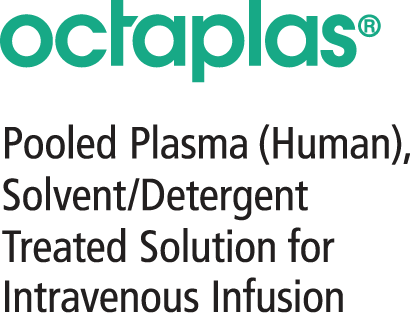Octaplas Indications and Important Safety Information
Indications and Important Safety Information for octaplas®, Pooled Plasma (Human), Solvent/Detergent Treated Solution for Intravenous Infusion
Please see octaplas full Prescribing Information.
Indications and Usage
Octaplas® is a solvent/detergent (S/D) treated, pooled human plasma indicated for replacement of multiple coagulation factors in patients with acquired deficiencies due to liver disease or who are undergoing cardiac surgery or liver transplantation; and plasma exchange in patients with thrombotic thrombocytopenic purpura (TTP).
Contraindications
Octaplas is contraindicated in patients with immunoglobulin A (IgA) deficiency; severe deficiency of protein S; history of hypersensitivity to fresh frozen plasma or to plasma-derived products including any plasma protein; or a history of hypersensitivity reaction to octaplas.
Warnings and Precautions
Transfusion reactions can occur with ABO blood group mismatches. Administration of octaplas must be based on ABO-blood group compatibility. High infusion rates can induce hypervolemia with consequent pulmonary edema or cardiac failure. Excessive bleeding due to hyperfibrinolysis can occur due to low levels of alpha2-antiplasmin (also named plasmin inhibitor). Thrombosis can occur due to low levels of Protein S. Citrate toxicity can occur with volumes exceeding one milliliter of octaplas per kg per minute. Octaplas is made from human plasma and may carry a risk of transmitting infectious agents, e.g. viruses, the variant Creutzfeldt-Jakob disease (vCJD) agent, and theoretically, the Creutzfeldt-Jakob disease (CJD) agent.
Adverse Reactions
The most common adverse reactions observed in ≥ 1% of patients included pruritus, urticaria, nausea, headache, paresthesia. Serious adverse reactions seen in clinical trials were anaphylactic shock, citrate toxicity and severe hypotension.
Please see octaplas full Prescribing Information
